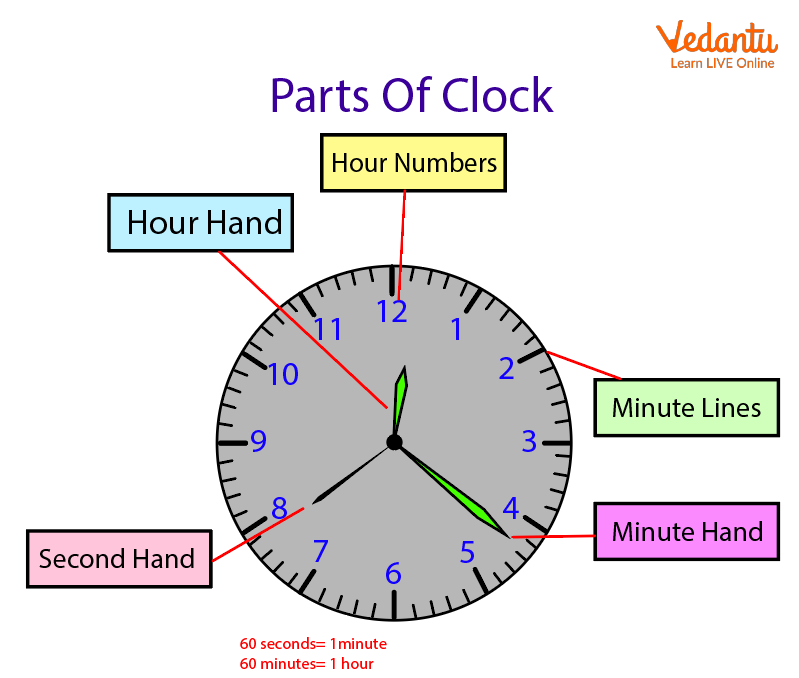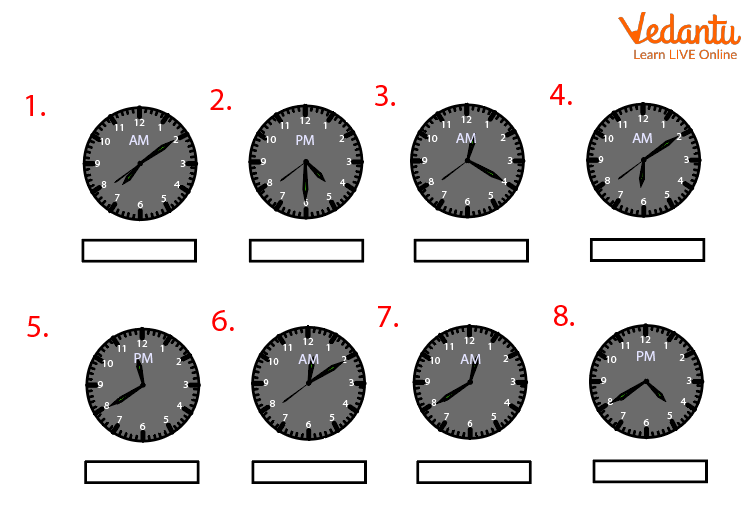




Time Reading on a Clock
To determine the time, you can carefully study clocks or quickly glance at the hour hand. Most clocks include hands that indicate the minutes or hours, and each hand can display the current hour in either analog or digital format (an unusual type).
Anything that moves constantly is an analog, therefore the big round clock in your classroom with three sticks spinning around is called an analog clock.
When a typical analog clock shows the time 8:22 and seconds, it could mean. 8:22 a.m or you can't tell from an analog clock if the time is morning (a.m.) or afternoon (p.m.).
Most analog clocks will have three sticks mounted within the center that spins around the clock to tell you the time. These are called clock hands.
Terms of Clock

Parts of a Clock
Hour Hand
The little hand is the hour hand. When the little hand is between two numbers, it tells you we are between those two hours. The shorthand or little hand makes one full rotation around the dial in hours.
For example: In the above image the time is 12:22:38. The hand which is near 12 is an hour hand showing 12 hours.
Minute Hand
The longer hand on the clock is named the minute hand. The long hand or big hand moves around the circular dial one time in one hour.
For example: In the above image the time is 12:22:38. The hand which is near 4 is a minute hand showing 22 minutes.
Second Hand
The very thin hand that's usually just as long as the minute hand is the second hand. It moves just one occasion around the dial in one minute and indicates the seconds of each minute.
For example: In the above image the time is 12:22:38. The hand which is near 8 is a second hand showing 38 seconds.
Analog Clock Face
An analog clock or watch is one that uses hands that move and numbers from 1 to 12 to indicate the hours to display the time. 24 hours make up a day. All 24 hours of the day may be identified by a clock with marks from 1 to 12. Roman Numerals (I, II, III, etc.) or no numbers at all can be seen on certain clocks! To tell the time, random analog clocks employ angles. They feature hands that move around the face of the clock.
Clock Reading
How to Read an Analog Clock
To read an analog clock, start with the hours. Examine the shortest hand only; this is the hour hand.
The little hand will point directly at a number only 12 times in 12 hours. Most of the time, you'll see it pointing between two numbers.
When the little hand is pointed directly at a clock number, you recognize it is exactly that hour. When the little hand is in between two hours, the amount behind the hand is the current hour.
For example, if the hand is past 1, then we are at a time between 1 o’clock and 2 o’clock. If the hand is past 3, then we've passed 3 o’clock and are approaching 4 o’clock.
Next, we determine the minutes. When measuring minutes or seconds, we've to multiply the printed numbers times 5:
\[1 = 5\]
\[2 = 10\]
\[3 = 15\]
\[4 = 20\]
\[5 = 25\]
\[6 = 30\]
\[7 = 35\]
\[8 = 40\]
\[9 = 45\]
\[10 = 50\]
\[11 = 55\]
\[12 = 60\]
When the big hand is pointing to the 1, it indicates 5 minutes past the present hour. If you divide the dial into four quarters, when the big hand is pointing at the 12, it's a new hour. When it points at the 3, we are past the hour.
When the big hand points at the 6, it's two-quarters past, but we are saying half past the hour because this minute hand is halfway around the dial. This is often equal to one-half hour of elapsed time.
When it's pointing to the first little marker between the 1 and the 2, it indicates that it's 6 minutes past the current hour.
The second user works the same way. It just indicates seconds rather than minutes, and when it's made one full rotation around the clock, it indicates one minute has elapsed.
Clock Timing in English
How to Read the Time of the Hour
To tell the time of the hour, say the hour by number and add o’clock to the top of it. Let’s explore the way to tell time on the hour, using the examples below starting from 1-12.
Time Written in English
\[1:00\] It's one o'clock
\[2:00\] It's two o'clock
\[3:00\] It's three o'clock
\[4:00\] It's four o'clock
\[5:00\] It's five o'clock
\[6:00\] It's six o'clock
\[7:00\] It's seven o'clock
Exact timing
Time Written in English
\[1:18\] It’s one hour and eighteen minutes
\[2:23\] It’s two hours and twenty-three minutes.
\[3:47\] It’s three hours and forty-seven minutes.
Time Reading

Time Reading Example
Ans:
1. 5:30
2. 4:00
3. 6:30
4. 8:30
5. 12:30
6. 6:00
7. 9:00
8. 11:00
9. 9:30
Solved Questions

Time Reading Solved Question Picture
Ans:
1. 7:10 AM
2. 4:30 PM
3. 12:40 AM
4. 6:10 AM
5. 11:40 PM
6. 12:10 AM
7. 12:40 AM
8. 4:40 PM
Summary
In this chapter, we have discussed clock timing. An analog clock is nothing but a timekeeping device with numbers around the edge with hands that rotate around to indicate the time. That device is known as a clock. We have studied the terms related to clocks like a hand, hours, minute, etc.
FAQs on Clock Reading
1. How do you read the time on an analog clock step-by-step?
Reading an analog clock involves looking at its hands in a specific order. Here is a simple guide for beginners:
- Identify the hour: Look for the shorter hand, which is the hour hand. The number it is pointing to, or has just passed, is the current hour.
- Identify the minutes: Look for the longer hand, which is the minute hand. To find the minutes, multiply the number it points to by 5. For example, if it points to 4, it means 20 minutes (4 x 5).
- Combine the two: If the hour hand is just after the 2 and the minute hand is on the 6, the time is 2:30.
2. What are the different hands on a clock and what do they represent?
An analog clock typically has three hands, each moving at a different speed to show a different unit of time:
- The Hour Hand: This is the shortest and slowest hand. It completes one full rotation in 12 hours and indicates the hour.
- The Minute Hand: This is the longer, faster hand. It completes one full rotation in 60 minutes (or one hour) and points to the minutes.
- The Second Hand: This is usually the thinnest and fastest hand. It moves around the clock face once every 60 seconds (or one minute) to track the seconds.
3. Why does the minute hand pointing to '3' mean 15 minutes, not 3 minutes?
This is a key concept in reading a clock. The numbers 1 through 12 on a clock face are primarily for telling the hour. For minutes, the clock face is divided into 60 small marks, one for each minute. The large numbers serve as convenient five-minute markers. Therefore, to calculate the minutes, you must multiply the large number the minute hand is pointing to by five. For example, when the minute hand points to 3, it means 3 groups of 5 minutes have passed, which equals 15 minutes.
4. How can you tell the time for 'quarter past' and 'half past' an hour?
These are common phrases used to describe time based on the minute hand's position.
- Quarter Past: This means 15 minutes have passed after the hour. This happens when the minute hand is pointing directly at the number 3 (a quarter of the way around the clock). For example, 7:15 is often said as 'quarter past seven'.
- Half Past: This means 30 minutes have passed after the hour. This happens when the minute hand is pointing directly at the number 6 (halfway around the clock). For example, 10:30 is called 'half past ten'.
5. What is the main difference between an analog and a digital clock?
The main difference is how they display the time. An analog clock shows time using moving hands on a numbered dial. You read the time by interpreting the position of the hour and minute hands. A digital clock, on the other hand, shows the time directly as numbers, for example, 08:30, making it easier to read at a glance.
6. Why does the hour hand move slowly between numbers instead of jumping from one to the next?
The hour hand's slow, continuous movement shows the progression of time within the hour. Its position is proportional to the minute hand's position. As the minute hand completes its 60-minute journey around the clock face, the hour hand gradually moves from one hour number to the next. This is why at 6:30, the hour hand is not on the 6 but is exactly halfway between the 6 and the 7, showing that half of the hour has passed.
7. What do a.m. and p.m. mean and why are they important?
Since a 12-hour analog clock repeats its cycle twice a day, we use a.m. and p.m. to specify which cycle we mean.
- a.m. (ante meridiem): This stands for 'before midday' and refers to the time from midnight (12:00 a.m.) to noon (11:59 a.m.).
- p.m. (post meridiem): This stands for 'after midday' and refers to the time from noon (12:00 p.m.) to midnight (11:59 p.m.).









